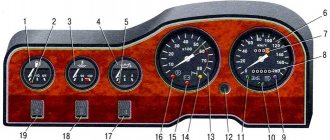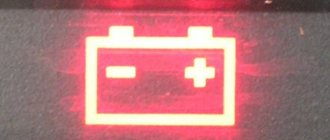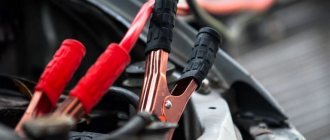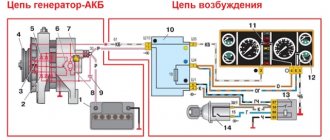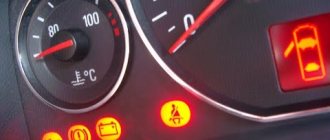When you start the engine, many different lights come on on the dashboard, one of them is the battery charging light. Ideally, it lights up as soon as you start the engine and goes out after a while. This indicates that the generator and all its circuits are fully operational and the battery receives a charge of 13.7-14.3 Volts, that is, it is charging.
However, various breakdowns often occur due to which the light bulb continues to glow, glows dimly, or does not light at all. To deal with such malfunctions, you need to understand a little about the design of the generator and the principle of its interaction with the battery.
A little theory
On our website Vodi.su we have already described in detail the design of a car generator. Let's just say that electricity is generated in it by the rotation of the crankshaft. As the speed increases, the voltage also increases, but it must be within the limits indicated above, otherwise the battery will be overcharged, which threatens the electrolyte boiling and sulfation of the plates.
To prevent this from happening, a relay regulator is installed in the rotor excitation circuit, thanks to which a stable voltage is supplied to the battery.
The signal from the generator to the warning lamp is transmitted through a fuse, which is also located in the generator itself. Accordingly, the light stays on until the generator starts working and transmits voltage to the battery.
The charge from the generator passes through:
- diode;
- regulator;
- generator brush;
- slip rings;
- winding and wiring.
Thus, if at least one of these elements does not work correctly or fails, the readings of the light bulb cannot be trusted, although charging may be supplied to the battery.
Why is the battery charging light on?
There can be a lot of reasons. So, if after starting the engine the warning light continues to burn at full intensity, most likely the alternator belt has stretched and needs to be replaced. At the same time, you can hear characteristic sounds from the engine. On Vodi.su we have also already told you how to tighten or change a belt.
The second common cause is poor contact at the battery terminals or at the terminals from the generator. Contacts oxidize over time and need to be cleaned.
Failures in the mechanical part of the rotor: the bearing fell apart, the bushings flew off. You will have to completely remove the generator, disassemble it and replace broken parts. Fortunately, you can always find a repair kit of three bushings for a VAZ-2107 or other domestic cars on sale.
Failure of the diode bridge, relay regulator. In this case, you need to check them with a multimeter, or contact a specialist. Repairs often cost more than purchasing a new generator.
Over time, graphite brushes also wear out and need to be replaced regularly. When they are worn out, the charge is not transferred to the winding, and accordingly the light bulb begins to glow dimly, although the charge is transferred, but very weakly. Use a voltmeter as a guide. If the brushes are not changed in time, the battery will constantly be undercharged, which can lead to gradual shedding of the plates.
Generator diagnostics
First of all, the voltage is measured at the battery terminals. If it is lower than required, you need to check the entire circuit step by step:
- belt tension level;
- measure the voltage at each of the generator terminals - at each terminal it should be half as low as at the battery;
- check fuses, relays, diodes;
- check the resistance in the dashboard, the quality of soldering of wires.
If it turns out that the breakdown lies in the generator itself, it will have to be removed and also checked. In particular, they first check the relay regulator, then measure the resistance of the rotor field winding using an ohmmeter. It should not be lower than 4.5 ohms. Also, using the tester, you can determine whether the winding circuit is open.
It is clear that such malfunctions cannot be avoided. However, there are simple tips to help extend the life of the generator:
- first of all, regularly check the quality of its fastening - constant vibrations lead to mechanical damage;
- Clean external surfaces from time to time;
- check the belt tension, tighten if necessary;
- quality of the rotor bearing - remove the belt and spin the rotor, it should rotate smoothly, without play or clicks.
You also need to monitor the quality of the connection of the wires to the generator and voltage regulator.
Thus, a lit battery charging light while the engine is running is a serious reason to make a diagnosis. Please note that it can also light up if you have installed a lot of additional equipment - subwoofers, lights, lights.
Welcome, friends, to the DIY auto repair website. When you turn the ignition key, a number of warning lights come on on the dashboard. They signal that the system is working properly and the engine is ready to start.
The battery charging light is on
One of these indicators has an image of a battery. When you turn on the ignition, it starts to light up, and after starting the engine, it goes out.
This indicates that the battery is charging. But what if this does not happen? Why does the battery charging light stay on even after starting?
Theory “on fingers”: how everything works
On the VAZ 2107, devices can receive power from 2 sources. The first is the battery, the second is the generator. The battery supplies energy when the engine is turned off. It has a certain charge, consumed as needed. The generator produces electricity, but only if the rotor is spinning. That is, with the engine running.
Battery operation diagram: 1. Battery, 2. Negative diode, 3. Additional diode, 4. Generator, 5. Positive diode, 6. Stator winding, 7. Regulator, 8. Rotor winding, 9. Capacitor, 10. Mounting block, 11. Control lamp, 12. Voltmeter, 13. Ignition relay, 14. Lock.
The battery charge is used to start the engine. When the engine starts running, the battery energy is not consumed: the generator supplies all devices with it. A charge is also supplied to it to restore wasted energy. But if the battery is not charging, its own energy will be enough for a limited number of starts. The battery will then be completely discharged. And the car owner will have to solve the problem of how to start a VAZ 2107 if the battery is dead. After all, not everyone has “crocodiles” in their trunk, and not everyone will agree to share electricity with their battery.
The lamp works when the engine is on: how to identify the cause
Check how intensely the icon lights up and when it happens. Based on this, you will understand where the problem lies.
Constant light
Most likely, the problem is that the battery needs more charge while driving. The causes of this problem may also be:
- weakening;
- complete or partial wear of the alternator belt;
- regulator relay burnout;
- breakdown of generator brushes.
In any case, it is necessary to replace the failed element.
On turns
The problem lies in the diode bridge or in another system. For the most accurate diagnosis, it is recommended to seek help from specialists.
At high speeds
The slip rings are worn out. The problem may also be caused by a poorly tensioned alternator belt, faulty bearings or alternator brushes.
Idling
To find a defect, you need to examine the alternator belt, regulator and diode bridge. If the indicator is bright, start checking from the bridge; if it is bright, start checking from the relay.
Blinks, lights up periodically, dims
A flashing (dim) pictogram indicates abrasion of the copper armature rings or generator brushes. You need to stop using worn out parts and buy new ones.
If the charge lamp barely lights up, you need to check the generator brushes
When turning on the headlights and turn signals
It is necessary to check the contacts of the diode bridge, the condition of the generator or commutator brushes.
Burns barely noticeable
A lamp that burns at full intensity indicates a faulty diode bridge or insulation. To solve the problem, it is recommended to replace the bridge. Also, poor indicator performance may mean that the ignition key is not turned all the way - in this case, you just need to pour a little WD-40 into the ignition switch hole.
For better performance of the battery charge indicator, you should drop WD-40 into the ignition switch well
With the ignition off
The fault lies in the generator. Unfortunately, the car owner cannot do without replacing it, and this is fraught with significant financial expenses.
While charging
If charging is carried out, but the light continues to burn, then it is necessary to clean the oxidized contacts. Sometimes it may be necessary to transfer mass from the battery to the starter.
Indicator light
As can be seen from the diagram, the charging system involves a large number of components and each of them can cause poor charging or its absence. To monitor the battery charging process, the car's dashboard is equipped with a control light.
If the system is in good working order, the control signal turns on after the factory. But when the engine enters operating mode, the VAZ 2107 battery charging light does not light up. This means that the battery's energy supply is replenished from the generator. At the same time, the needle on the voltmeter moves to the green sector.
Signs of a battery not charging:
- The VAZ 2107 battery charge arrow twitches.
- The control signal does not go out. In some cases, the VAZ 2107 battery light blinks.
- The voltmeter needle does not go to the green zone after starting the engine.
- When the engine is running, the voltage on the battery should remain around 13.9.
- The permissible deviation in any direction does not exceed 0.3 V. Undercharging of the VAZ 2107 battery within these limits is not yet dangerous.
A voltage drop to 12 V says: the generator is not charging! lamp is dimly lit - the battery is undercharged.
When the ignition is turned on, the battery (generator) lamp does not light up.
The battery light does not light up when you turn on the ignition. If the battery light does not light up when you turn on the ignition, then this is a reason to conduct a full test of your car.
This type of problem is quite common; almost every experienced motorist encounters it. The danger of this malfunction is that a breakdown can occur somewhere far from crowded places, at night in winter. Then repairing or replacing a damaged part will not be so easy.
Where to start checking
If the VAZ 2107 battery icon does not light up, the voltmeter gives normal readings, but the battery does not charge, which means there is no (or insufficient) contact at the terminals. Their severe oxidation can cause the voltage from the generator to the battery simply not to flow. Therefore, it is necessary to remove the terminals, thoroughly clean them, as well as the battery terminals, then reconnect the battery to the on-board network and check the functionality of the charging system.
In the case when the voltage on the VAZ 2107 battery is still below normal, you need to measure it at the output from the generator with the engine running. Is there a big difference between the readings on the terminal and on the battery? Try cleaning the contacts and checking the wire connecting the battery to the generator. Broken - requires replacement.
The next element that is checked is the generator drive belt. If it becomes loose, it will slip along the pulley, which is why the generator will not be able to generate the required amount of electricity. And although charging will be carried out (provided the circuit is in good condition), it will not be enough. At the same time, the engine is running, the voltmeter shows the norm. However, if the system is loaded a little more - for example, by turning on the headlights - then the voltage drops sharply. Then, if the battery charge on a VAZ 2107 disappears, this indicates that the tension belt is loose and slipping. The belt should be tightened; if it wears out during operation, replace it. But you can’t overtighten either: excess belt tension puts an overload on the pumps and generator bearings.
The third component of the circuit that is checked during the initial diagnosis is fuse No. 10 (in the fuse box). It is he who is responsible for supplying voltage to the battery: the VAZ 2107 battery charging fuse has blown - the system will not work.
If everything is in order with the terminals, belt, fuse, the reasons for poor charging of the VAZ 2107 battery need to be looked for further.
Useful tips
To prevent your car from having problems charging the battery, use the following tips:
- Don't ignore your car's dashboard signals. In this case, you will be able to solve the problem at the initial stage of its development.
- Inspect the alternator belt regularly. The correct operation of all electrical equipment on board directly depends on it. If there are any defects, replace it as soon as possible.
- Check the voltage from the generator to the battery. If you notice a discrepancy, diagnose the on-board network.
- Periodically pay attention to the condition of the battery terminals. If you notice oxidation, eliminate this defect. They can be treated with WD-40.
- Isolate the generator and battery from water to prevent short circuits. Leave engine washing to professionals.
- When repairing the battery charging circuit, do not use cheap spare parts.
To summarize, we note that the battery is the most important element in the car’s electrical network. Therefore, you should carry out timely maintenance of the charging circuit and, if necessary, change the necessary parts. In this case, you will ensure a proper system of work. In the article, we told you about the main malfunctions that can cause the battery charging lamp to light up and what to do about it. We hope our recommendations will help you in solving the problem at hand.
Source
What else to check
- Voltage regulator;
- Generator rectifier unit;
- Diodes;
- Generator for broken windings;
- Generator brush assembly;
- Contacts on the terminals of the generator, mounting block.
A malfunction of any of these elements leads to the fact that the charging system is inoperative and the VAZ 2107 battery is not charged.
Let's continue... Diodes are checked with a test light or multimeter. If one of them is broken, the entire rectifier will have to be replaced.
Diode bridge faults
The electrical circuit is designed to convert alternating voltage to direct voltage. If a breakdown of at least one of the diodes occurs, the functional unit ceases to perform its duties. The consequence of this is the supply of voltage that does not correspond to the required indicators.
The rectifier needs to be checked when the battery charging light is on, but there is charging.
You can determine the breakdown by using a multimeter. Take a tester and connect the red probe to the positive of the bridge, and the black one to one of the contacts marked AC.
The throughput voltage for diodes (silicon) ranges from 400 to 1000 mV. If the tester shows different values, then the bridge needs to be changed. Such a unit cannot be repaired.
What to consider when choosing a new battery
According to the passport, the battery is designed for 3-5 years of active use (in reality it turns out to be less). Therefore, over time, it becomes necessary to buy and connect a VAZ 2107 battery instead of a failed one.
When purchasing a new battery, you should consider a number of parameters and characteristics. Battery type: serviced and maintenance-free. The first option allows you to check and replenish the electrolyte level. This makes it possible to use the battery longer.
The next question is: what power will the battery on the VAZ 2107 be most efficient. Batteries with a capacity of 50–60 Ah are suitable for this model. However, given that modern cars are equipped with energy-intensive equipment, it is better to opt for more capacious batteries. In addition, carburetor VAZ models require more powerful batteries - they consume more energy when starting. In terms of dimensions, the VAZ 2107 requires power supplies with dimensions of 242*175*190 mm. The vast majority of samples available on the market fit them.
When choosing a battery, you should also take into account the place of residence of the owner of the “Seven”. For those who live in the south, you can purchase a less powerful battery. Northerners are advised to prefer a battery with a higher capacity: in the cold, the car starts with high energy consumption.
What to do if the battery light is on or the light is off but there is no charging: diagnostics
In a situation where the battery light is on while the engine is running, you need to check the voltage at the battery terminals with a multimeter. This can be done quickly, and the voltage itself should normally be 13.5-14.3V. When there is no charging, the voltage will be about 12V.
To check the charging status in more detail, you need to prepare a pair of screwdrivers (flat and Phillips), a 12V test lamp, a multimeter, a knife and pliers, as well as fine sandpaper. Now let's look at the main problems when the battery light comes on.
- First, the generator is charging, the tester at the battery terminals shows a voltage of 12V, and the battery itself is discharged. In such a situation, stripping of the terminals and wires will be required. After cleaning, the voltage on the battery is measured again.
- Secondly, the battery is discharged, and the voltage on the battery is 14V, but it drops under load. In this case, the cause may be poor tension of the generator belt, problems with the pulley, failure or wear of the generator bearings.
You also need to check the diode bridge and stator winding, since a breakdown of one diode can lead to insufficient charging. To believe this, you need to turn off the ignition, then check the generator, its diodes and other elements with a multimeter. At the same time, the generator brushes are also checked (if their length is less than 5 mm, the generator brushes need to be replaced).
Confronting attackers
Due to the fact that the battery is not cheap, the issue of protecting the VAZ 2107 battery from theft is quite acute. It’s not difficult to open the hood of a “classic,” which is why thieves are keeping a close eye on the “Sevens.”
Experts offer several options for preventing theft.
- Secure parking or secure garage.
- installation .
- Installation of the hood lock. Let’s be clear right away: few people take this step. Welding work is required, the appearance deteriorates, and it is quite easy for a professional to pick the lock.
- Take the battery with you. Labor-intensive, inconvenient, but effective. On the other hand, if the car is left for a short time, it is defenseless: they can even remove the battery in a supermarket parking lot.
- Reliable battery fixation. Almost the most popular method. The fasteners are secured with a secret that prevents dismantling and makes theft difficult. In combination with an alarm it is a very effective technique.
But all experts agree that the most reliable protection for the VAZ 2107 battery against theft is comprehensive. A combination of multidirectional measures will give the best results!
How to troubleshoot
To understand why this light is on, do not turn off the engine. You need to open the hood of the car and, with the engine running, measure the voltage that will be at the battery terminals with a load plug or multimeter. 13.5-14.5 Volts is considered normal. If charging is not occurring, the voltage will be 12 Volts or lower.
- A couple of screwdrivers - slotted and Phillips
- 12-volt lamp (control)
- Knife
- Pliers
- Sandpaper
- Multimeter
Different malfunctions are resolved in their own way, so I will list in turn all the possible options and methods of elimination.
Option one
The battery light is on and does not blink. When the multimeter shows approximately 12 Volts at the battery terminals, and the engine is started, but the battery itself is discharged. You need to clean the battery terminals with sandpaper, then the high voltage wires. Having cleaned the terminals and returned them to their place, we measure the voltage on them with the engine running.
When the situation does not change, check the voltage at pin “30” on the electric generator. To do this, we lean one multimeter probe against terminal “30”, the second probe against ground. If the voltage is higher than the voltage of the battery terminals, then the contact of terminal “30” must be cleaned. If necessary, replace the wire that goes from this terminal to the battery.
Option two
The battery light is on, but charging is in progress, but under load (headlights or signal) the lights blink. The battery has a reduced charge level. A possible reason is loose tension in the generator belt, pulley, or play in the generator bearing.
In addition, the cause may be a diode bridge and a broken stator winding. You need to turn off the ignition and use a multimeter to check all the diodes one by one; if a breakdown is detected, replace the diode or the entire bridge.
You also need to check the condition of the generator brushes. The remaining length of the brushes must be at least 5 millimeters, otherwise they must be replaced. Once you get into the brushes, check the condition of the holders, maybe they are worn out and causing problems for you.
Option three
In this option, the battery lamp does not light up or blink, the charge sensor does not work, but the battery does not receive charging. This means the fuse has blown. The fuse is marked “F10” and is ten-amp. It happens that after replacing it the result has not changed. Then look for a faulty ignition switch, or a problem with the ignition relay.
Option four
When the battery lamp does not light up after turning on the ignition, there is no charge, and the lights work normally. You need to remove the wire from terminal “61” on the electric generator, after which you connect the wire to the body. If this causes the battery light to light up, then its excitation winding has burned out.
An oxidized connector contact on an electric generator gives a similar effect, clean the connector. We don’t rule out the possibility that the light bulb simply burned out; it doesn’t last forever. When only one battery light blinks or glows dimly, the problem is also in it itself. If this is not the problem, then other devices and light bulbs will behave in the same way, that is, they will all blink in the same way, or glow at the same level.
Option five
The battery light is on or blinking, charging is missing or intermittent. Check the connector in the instrument panel to see if the contacts are corroded. Clean if necessary. Check the operation of the relay regulator. To check it, you need to power it up and measure the voltage on the generator brushes. When the voltage on the brushes is 12 Volts, then the relay is working properly. If not, the relay regulator will have to be replaced.
Video - Battery protection from theft
The car dashboard contains not only analog gauges, but also various indicators. One of the main indicators is a battery icon, which lights up red when the ignition is turned on, and goes out as soon as the engine starts. If the battery charging lamp on a VAZ 2107 lights up after starting the engine, this indicates a malfunction of the generator. If the generator is working properly, and the battery is charging, and the lamp is on, then the reasons for the indicator light need to be looked for.
Troubleshooting
If you have identified the reason for the activation of this indicator, it’s time to start eliminating it. Below are the main problems and methods for solving them:
- You can eliminate the weakening of the belt or its rupture by adjusting the degree of tension or resort to replacing it;
- in order to clean oxidized terminals, it is enough to clean them using fine-grained sandpaper;
- in the event that the battery is discharged as a result of prolonged operation of electrical appliances with the engine turned off, it is enough to recharge it;
- If there are various internal damages, you should contact a specialist.
Faults such as failed “brushes” and generator wires, as well as broken windings or broken relays cannot be eliminated by repair. In this case, it is advisable to replace the spare part.
conclusions
By carefully monitoring the dashboard readings, you will be able to independently identify problems in the operation of your vehicle at first and avoid serious consequences. We also draw your attention to the fact that you can always order the parts you need from our company. We offer competitive prices and will help you save not only money, but also time, because you will not need to look for the necessary spare part in stores. We guarantee high quality and excellent performance. To place an order, call the contact phone number.
Reasons for the battery charging light to glow
Such bulbs are available in VAZ 2107 injection and carburetor type cars. If, after starting the engine, the indicator in the form of a battery continues to light on the instrument panel of the VAZ 2107, then the owner’s first opinion is that the generator is faulty. This is a correct opinion, and in order to find the exact cause, you will need to carry out diagnostic measures. The reasons for the glow of the lamp on the instrument panel are:
- Weakening of the tension of the generator belt, as well as its wear and damage.
- The fuse link burns out.
- Malfunction of the relay regulator or rectifier (diode) bridge.
- A break occurs in the generator winding.
- Poor contact at the battery terminals.
- Abrasion of graphite brushes on the generator.
- Lack of ground contact.
You cannot operate a vehicle with a glowing battery indicator on the instrument panel. At any moment, the battery can be discharged, since it is not receiving charge from the generator, and the car will simply stall. How long a vehicle can drive with a faulty generator depends on the quality of the battery, its charge and the vehicle’s electricity consumption. Typically this period of time ranges from 10 minutes to 2 hours.
What can a constantly burning battery charging lamp indicate?
Another situation that some owners of domestic cars are familiar with is when the VAZ 2107 battery charging lamp is on, but charging is in progress. What could be the reason, how dangerous it is, and how to eliminate it, we will find out further.
When the battery light is on, but there is charging, the reasons are also hidden in the malfunction of the generator. The car battery has an operating voltage of 12V, and to charge it requires 13.5 to 14.4V. In this case, the battery will be charged, and the lamp on the parting panel will not light up when the engine is running. If the indicator lights up after starting the engine, then there is a high probability that the generator is delivering insufficient voltage to the battery (that is, below 13.5V). If, when measuring the voltage at the battery terminals with the device while the engine is running, the device shows a value of more than 12V, but less than 13.5V, then you need to sound the alarm and start troubleshooting.
Failure of the relay regulator
A malfunction of the relay regulator is another reason why the battery charging light comes on.
This node is responsible for turning on/off the signal indicator. The principle of operation of the device is as follows: when the ignition is turned on, current flows through its closed contacts, which comes from the battery and feeds the indicator signals. When the internal combustion engine starts, the generator starts working, which supplies the relay with already rectified voltage and the contacts of the unit open. At this time the light should go out.
A little theory: scheme of work
To solve the existing problem, you must understand the essence of the interaction between the vehicle generator and the power source (battery).
While driving, the battery is in constant charging mode with a voltage of 13.6-14.2 Volts. As engine speed increases, the voltage at the generator output increases. But this is unacceptable.
To limit the voltage, a small relay regulator is inserted into the rotor excitation circuit. Its task is to reduce the current to a normal level (even with a significant increase in the speed).
The result is maintaining the battery charge voltage at a stable level. If the battery light is on, this indicates a lack of charging from the generator.
How does the scheme work? After turning on the ignition, voltage through fuse No. 10 (for VAZ-2107) is supplied to the battery charge indicator lamp.
Next, the “+12V” voltage passes through a diode, a built-in relay-regulator (we mentioned it above), a brush, a slip ring and a winding.
As soon as the rotor speed increases, the phase voltage also increases. As a result, the voltage at the terminals of the battery warning light is equalized and it goes out. At the same time, the battery is charging.
Troubleshooting - Battery
Often, failures that result in a lack of charge occur when the battery is faulty or there are problems with the generator.
To detect deviations in battery performance, it is enough to compare the performance of the power source installed in the car and the new one. If the light goes out when replacing this part, you can confidently conclude that the cause of the failure was a failed battery. This can happen as a result of sulfation of the plates or their short circuit. And if in the first case it is possible to revive the device by repair, then in the second it will have to be replaced.
It is also worth remembering that problems associated with the battery do not always indicate a breakdown. Quite often the power supply simply runs out of charge. It's quite easy to check. If the battery charge level is below the usual norm, the power source must be charged and installed in the vehicle. If after this you were able to start the car and the indicator went out, the problem has been resolved and you can continue to use this battery without fear. But if the required charge level cannot be restored even after recharging, you will need to purchase a new battery.
Reasons why the battery charging light is on
In fact, there are many reasons why the battery light comes on and does not go out. These include:
- Loosening of the belt tension on the generator, its wear or damage;
- fuse blown or deterioration of contact quality in the connectors of the mounting block;
- breakdown of the relay regulator, diode bridge, additional diodes;
- the appearance of a break in the generator excitation circuit;
- decreased quality of contact at the battery terminals or generator output;
- generator brush wear;
- lack of high-quality contact of the ground wire.
What to do if the battery charging light is on?
First of all, get out of the car and, with the engine running, measure the voltage at the battery terminals (do not remove the clamps under any circumstances).
If charging is in progress, the voltage should be at 13.6-14.2 Volts. In the absence of charge, the voltage level will be much lower - about 12 Volts.
To fix the problem, prepare the following tools:
- twelve volt indicator light,
- two screwdrivers (flat and Phillips),
- multimeter,
- pliers,
- knife,
- Use sandpaper to clean contacts.
So let's get started:
1. The readings of the on-board voltmeter indicate the presence of a charge, the charge signal lamp on the dashboard does not light up, there are about 12 Volts at the battery terminals, and the battery itself is almost discharged.
In such a situation, clean the wire connections on the power source itself. If these measures are useless, measure the voltage level at terminal “30” of the generator itself.
Place one multimeter probe on this terminal, and the other on ground. If the voltage here is much higher than at the battery, then strip the thirtieth terminal. If necessary, replace the wire from the generator to the battery.
2. The voltmeter on the dashboard and the lamp show the presence of a charge, but the battery is discharged.
The voltage on the battery is normal (about 14 Volts). Turning on a load (for example, headlights) causes the charge arrow to shift to the extreme left position.
The main reason is weak belt tension on the generator pulley (tension the belt, and if it is damaged, replace it).
This problem can also be caused by a breakdown of one of the diodes, as well as a break in the stator phase winding. Turn off the ignition and check the diodes with a multimeter. In case of breakdown, replace them.
Check the generator brushes. To do this, take them out and measure the length. If it is less than five millimeters, then it is better to replace the brushes.
3. When you turn the key in the ignition, the charge warning lamp does not light up, the charge sensor does not work, and there is no charge on the battery. The reason is a blown fuse.
Its designation is F10, rating is 10 Amperes. If installing a new fuse does not produce results, then the reason must be sought in the ignition relay or the lock itself.
4. After turning on the ignition, there is no charge, all devices work, the control warning lamp does not light up.
The check is simple - remove the wiring from terminal “sixty-one” of the generator and connect it directly to the “minus” (car body). If the light comes on, then the cause of the problem is the generator field winding.
The second option is bad contact in the connector. If after cleaning there is no result, then there is a risk of the lamp itself burning out.
5. When you turn the key in the ignition switch, the charge lamp lights up, and after starting it continues to light up. In this case, there is no charging or appears periodically. The reason is insufficient contact of the wire at the connector with the dashboard (it may oxidize).
Finally, check the relay regulator. To do this, apply voltage from the battery to its contacts. If there is 12 volts on the brushes, then the relay is working properly. If not, the device must be replaced.
If you have problems charging the battery (the warning light does not go out or does not light up at all), then check all versions.
But, as a rule, the problem is always on the surface, and the cause is poor contact, a burnt out light bulb or a faulty relay regulator. Good luck on the roads and of course no breakdowns.
How to identify generator malfunctions
If, after replacing the battery with a new one, the charging indicator does not go out, the cause of the failure is a malfunction of the generator. To determine the lack of voltage supply, you will need to carry out manipulations in the order below. Be sure to use personal protective equipment - each manipulation must be performed with rubber gloves to avoid electric shock. So, to identify the breakdown you will need:
Turn off the engine and disconnect the wires from the battery. Measure the voltage at the terminals using a multimeter. The optimal value should be between 12.5-12.7 V. Connect the wires, turn on the ignition and repeat the voltage measurement procedure again. The indicator should not exceed 13.5-14 V, and increase with increasing speed. If the voltage drops as the speed increases, this often indicates that the generator “brushes” have worn out or the diodes in the diode bridge have failed. Also, the reason for stopping the charge supply may be a loose or broken belt. You can verify this by performing a visual inspection. Press the belt with your fingers, and if it bends less than 1.5 centimeters, this directly indicates a weakening of the tension.
Visually, the driver can independently determine the oxidation of the terminals. To do this, you need to pay attention to the generator wires. If they have oxidized, this will be indicated only by their appearance, but also by the characteristic burning smell.
But also quite often there are global problems that even an experienced car enthusiast cannot cope with without qualified assistance from a specialist. It is worth noting that defects such as worn “brushes” or diodes can be completely eliminated, and more serious problems (open circuit or wear of rotor spare parts) can only be solved by replacing the generator.
Poor contact at battery terminals
Check the condition of the battery terminals and battery contact wires. It is not uncommon for oxidation to occur in these places and the contact to weaken significantly. When the lamp comes on and there is charging, this could be the cause.
In this case, the generator operates normally, voltage is supplied to the battery, but weakens due to insufficient contact. As a result, the warning light on the dashboard comes on. As a rule, the indication lights up dimly.
To fix the problem, you need to clean the terminals and contact pins. Additionally, treat these elements with a water-repellent agent.
Description of battery operation
A battery is a device with the help of which electrical energy is obtained from chemical energy and vice versa, with the ability to accumulate and store charge. The main purpose is to provide power to the electrical equipment of an idle vehicle, as well as to start the engine using the starter. If the generator does not work or cannot cope with the load, the battery takes over its role. The generator does not allow the battery to discharge, as it is a source of recharging.
Based on the type of electrolyte, rechargeable batteries are divided into two large groups: alkaline and acidic; based on the material of the electrodes, they are divided into:
- lead;
- zinc with the addition of silver;
- nickel-cadmium;
- iron-nickel.
Lead-acid batteries are the most popular. The principle of operation of the battery is simple: thanks to chemical processes, an electric current is generated, which is necessary to start the engine. A running motor receives electricity from a generator. In this case, electrical energy is obtained from mechanical energy. The battery receives electricity from the generator and converts it into chemical energy, storing it for further use.


